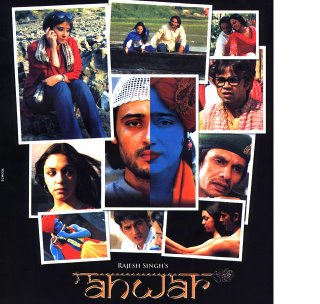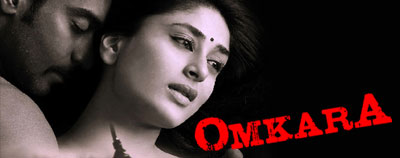
Recent hip-hop sounds, which captured the shelf space as sound tracks for some of the latest movies, left me completely dejected and I decided not to look at film tracks for my dose of music. Its not that all were bad; some of them were bearable enough, but after a certain time, they all sound like a cacophonous crescendo, especially when every radio station in town is in a mad race - who blurts them out more.
But as they say, ‘ignorance is bliss, not always’, which I learnt a tough way. Just the other day, while swapping TV channels, I discarded a sight of disheveled looking Siddharth Koirala in a rather unimaginative film promo, apparently for his new film, Anwar. Now I always had a fair share of skepticism about his acting prowess. Thus I must confess I wasn’t expecting anything from the movie, despite the fact that it’s another directorial venture by Manish Jha, who made critically acclaimed Matrabhoomi. It must have been something which prompted him to rope in such an unimpressive and weak cast, comprising of Koirala siblings, Nauheed Cyrusi, Hiten Tejwani, Vijay Raaz, Rajpal Yadav, Yashpal Sharma etc.
Human mind has such a short attention span and it is proved because what initially started as a discussion on recent music scene, took shape of a film’s criticism. So without being out of focus much, I return to the native – my intentions to write a review for Anwar’s music. Now I picked this one up despite my newly acquired irritation for film music because a friend informed me that Anwar’s soundtrack is designed by Pankaj Awasthi – my old favorite.
For the records, Pankaj Awasthi is a homegrown singer and music composer and has an album named ‘Nine’, a fascinating piece, to his credit. He also crooned the title track, ‘Tera hi karam’, for a film named ‘Karam’. Incidentally, I also have a CD, which has some of his unreleased, equally amazing, work.
Anwar has nine tracks and that makes me wonder, does Pankaj have something for figure 9. In Anwar, Pankaj shares the stage with Mithoon, but predominately, it’s Pankaj’s baby. The opening track, Muala is sung by inimitable Roop Kumar Rathod in his melancholic voice and style, which has become his signature of a sort. It is composed by Mithoon on Sayeed Quadri’s lyrics. The track is a fusion between Sufi styled renditions on a beautiful classical fabric. The song captures the very mood of film and sets the tempo right. Initially a slow number, it grows slowly on you, and the effect gets denser as it passes. I don’t doubt if the local lounges play it with a slight arrangements on turn tables.
The next is Dilber mera, which incidentally is a track from Pankaj’s album Nine. Those who have heard it in Nine are in for a treat. Without losing on the songs hypnotic quality, the music and lyrics has been tweaked a little. So it’s just another great version of an amazing song, a typical Pankaj Awasthi song. Shyam Ravindran wrote the song, who is Pankaj’s partner in crime, err...musical journey. The number is sung and composed by Pankaj himself. A transcending experience, this song takes you beyond – beyond the unknown; a wonderful mix of electronic and traditional sounds.
Bangla khula is the 3rd track. Here Sayeed Quadri has tried to do a Gulzaar and attempt is laudable. It’s sung by Megha Sriram in a husky tone. This track seems to confirm that item numbers have become an integral part of Indian films. It has a very rustic feel to it and reminds us of some of the raunchiest item numbers in the past.
A flute piece is called Anwar’s dream, is next. A very soothing and relaxing symphony by Pankaj keeps up the mood and paves way for something which is next to come.
5th track Jo maine aas lagayi starts with a distinctive haunting alaap by Pankaj Awasthi, a typical of him. The track lasts for two minutes, which is enough for Pankaj to inspire pathos and agony; composed and performed wonderfully by Pankaj himself.
Into the black is the 6th track. A semi instrumental and partly vocal track, it’s much on the lines of psychedelic trance, an evident trend that film music too is undergoing an experimentation age.
Mela sounds like an extension of the previous number, carrying forward the spirit Into the Black evoked. There is something with Pankaj’s voice. It fits into the bill, whenever he steps closer to microphone to croon. He executes it with certain fineness, only he mastered it. He mustn’t be a master vocalist but he surely knows his music.
8th track is the remixed version of Bangla Khula. Nothing much to say about it because the track doesn’t offer you much besides some hip shaking. But an item number, a remixed version at that is nothing about but jiving crazily, after all.
Last track is Tose naina laagey re by Mithoon on Kamal Hasan’s lyrics and sung by Kshitij & Shilpa Rao. A perfect song to seal the album, it is infused with Sufi spirits and haunting voices, heavily impregnated with classical texture. It talks about the metaphysical, the sublime love and its implications on human life. The track expresses the predicament of two souls in love with each other. True, the most beautiful songs in this world are the songs of love, pain and death.
The album may not become a hit, but it surely has a discerning audience. It’s a much shift from Pankaj’s previous work and those who put Nine and Anwar in the same league would be disappointed. But Anwar does have a distinct quality.






